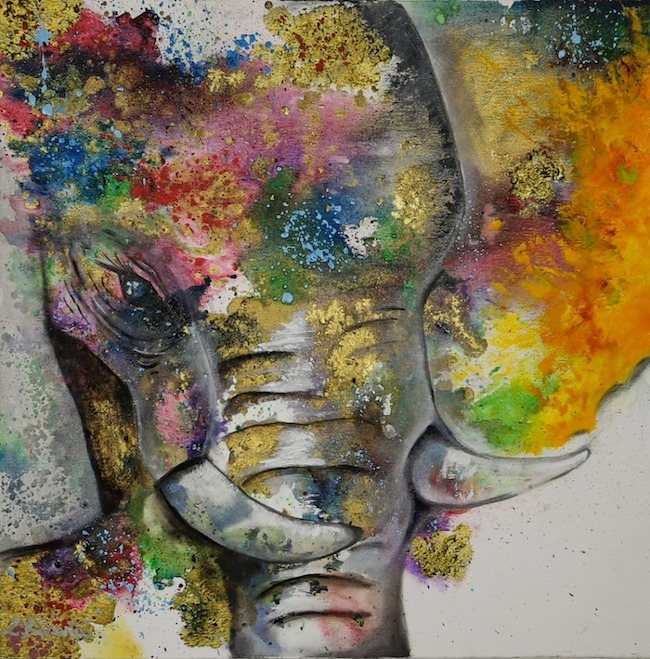Nell’arte contemporanea si osservano due tendenze opposte anche se generate dalla stessa radice intenzionale, quella cioè di affrontare la realtà contingente, una in cui la necessità di affondare all’interno di tematiche e sensazioni, anche cupe o negative, è la base dell’espressione artistica, l’altra invece dove si manifesta l’esigenza di evadere dal pragmatismo o dalla sofferenza interiore per rifugiarsi in un mondo in cui coltivare la piacevolezza, i sentimenti puri, quasi fanciulleschi a cui attingere per dar vita a un universo in perfetto equilibrio tra il sentire e le capacità di trasformare tutto ciò che circonda l’artista, rendendolo un luogo in cui perdersi per connettersi in maniera profonda con le emozioni. La protagonista di oggi appartiene a questa seconda categoria di creativi che preferiscono ridisegnare un mondo migliore piuttosto che soffermarsi dentro difficoltà e sofferenze che inevitabilmente appartengono al vivere attuale.
Intorno agli anni Venti del Novecento alcuni artisti cominciarono a manifestare l’esigenza di un ritorno all’ordine, un distacco dalle dinamicità eccessive del Futurismo e dalle deformazioni stilistiche dell’Espressionismo; in virtù di questa nuova necessità di trovare attinenza alla realtà osservata, senza però dimenticare le sensazioni e l’interpretazione del quotidiano generate da uno sguardo meravigliato sulle energie sottili che ruotavano intorno alla realtà oggettiva, vide la luce uno stile, più che un vero e proprio movimento, che prese il nome di Realismo Magico. Caratterizzato da un tratto realista e fortemente figurativo, il nuovo approccio pittorico aveva la caratteristica di evidenziare l’aspetto estraniante delle cose e di conseguenza dell’uomo che ne faceva parte, a volte riflessivo altre sognante come se da quella realtà si sentisse distaccato perché concentrato sulla sensazione di dover meditare su qualcosa di diverso, qualcosa di più simile al mistero nascosto dentro le cose, quello che i bambini nella loro innocenza e curiosità tendono naturalmente a osservare ed esplorare. Le opere di Felice Casorati, Antonio Donghi e Ubaldo Oppi mostravano un tipico senso di solitudine dell’essere umano, di cui gli artisti evidenziavano la capacità di sorprendersi, calando i personaggi nell’atmosfera piuttosto che nell’ambiente fisico che li circondava; tanto quanto Paul Cadmus, in tutta la sua produzione artistica, dipingeva invece scene affollate di persone, momenti di svago spesso grotteschi, sottolineando una promiscuità necessaria all’essere umano per non sentirsi solo ma evidenziando anche quanto risultasse impossibile ai suoi personaggi di mostrare felicità, quasi come se la noia e l’abitudine fossero sentimenti prevalenti. Con il proseguire del tempo il Realismo Magico assunse caratteristiche differenti e personalizzate sulla base della personalità dell’esecutore dell’opera, tendendo a volte verso il Surrealismo come nelle opere degli artisti Tomek Sętowski e di Jaroslaw Jaśnikowski i cui paesaggi onirici trasportano l’osservatore in un mondo inquietante e forse per questo affascinante, altre invece vanno verso il sogno, la magia, la capacità di modificare l’aspetto esteriore delle cose avvolgendole di fantasia positiva. A questo secondo intento espressivo appartiene Vladimir Kush, i cui paesaggi fatti di fiori, farfalle, frutta, riescono ad attrarre lo sguardo fino al punto di desiderare di far parte di quel mondo incantato. L’artista di origini siciliane Laura Risina mostra un’inclinazione più simile a quella di Kush pur personalizzandola sulla base delle proprie inclinazioni caratteriali, di quell’approccio personale che la induce a porsi in contatto con la propria sensibilità lasciando fuoriuscire il lato più fanciullesco, la sua innata capacità di mantenere la sorpresa e la meraviglia nello sguardo.
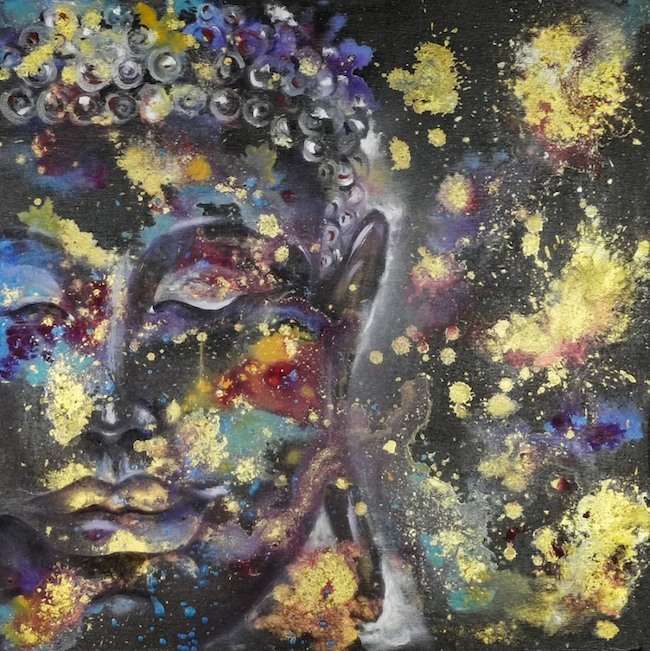
Questo lato puro e positivo si manifesta nella sua pittura attraverso immagini modificate rispetto alla realtà poiché assecondanti quella percezione differente con cui l’artista interpreta l’osservato, il vissuto; proprio in virtù del suo approccio positivo, incantato la Risina rifinisce le sue opere con un effetto spugnato che dà la sensazione di trovarsi davanti a un glitter, la cosiddetta polvere di stelle che da sempre fa sognare i bambini di tutto il mondo. Le atmosfere narrate divengono così magiche per la presenza dell’impalpabile effetto in grado di arricchire l’osservato comunicando il ventaglio poliedrico di emozioni che dall’interiorità di Laura Risina raggiungono le corde emotive del fruitore il quale si lascia conquistare non solo dall’immagine bensì anche dall’atmosfera che la evidenzia e che diviene parte stessa dell’opera, imprescindibile proprio perché per l’artista, come d’altronde per l’essere umano, non è possibile staccarsi da quel mondo interiore che è filtro di tutto ciò che lo sguardo coglie.
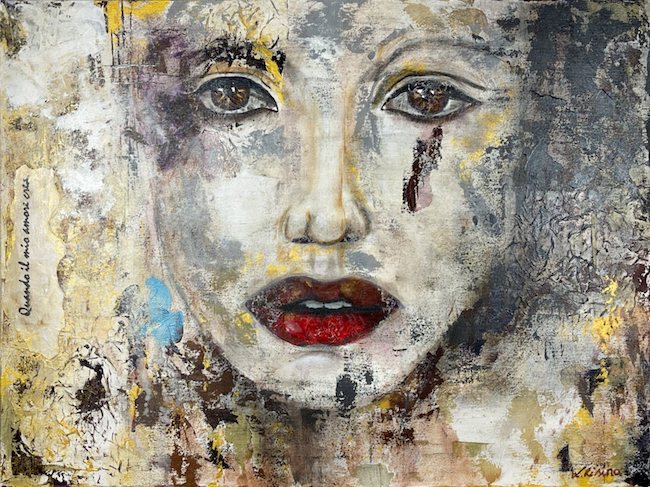
Ed è proprio il coinvolgimento emozionale di un frangente, di un semplice istante, quello che le permette di immortalare, un volto, un animale, un monumento, qualsiasi cosa che abbia catturato la sua attenzione, raccontandola però con quell’emozionalità in grado di modificare i colori reali per trasportarli nel mondo del sentire. Dal punto di vista cromatico dunque lo stile della Risina si avvicina all’Espressionismo per la caratteristica di accordarsi non tanto alla realtà quanto all’interiorità, tuttavia il suo tratto è legato all’immagine reale, la prospettiva esiste così come la descrizione dei suoi soggetti dunque la colorazione insolita trasporta il suo Realismo verso la dimensione incantata, poetica, magica appunto.
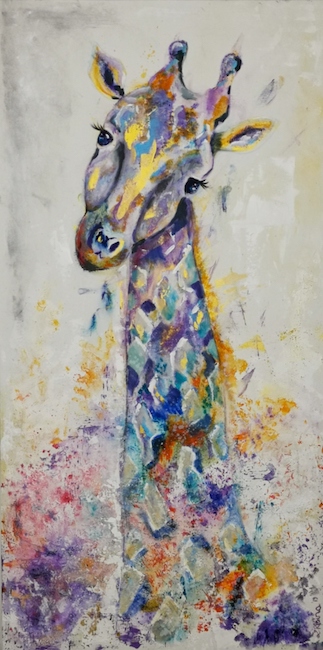
La tela Poesia, in cui sceglie un animale insolito, la giraffa, per raffigurare il suo approccio positivo alla realtà, per quel saper oltrepassare la contingenza e spingersi verso la connessione con le sue profondità, quelle che le permettono di immaginare un mondo diverso, più semplice e per questo più piacevole, dove gli animali non sono poi tanto diversi dall’essere umano e lasciano intravedere all’osservatore una loro personalità, una loro dolcezza, un tocco immaginario molto simile alla dimensione in cui vivono costantemente i bambini.
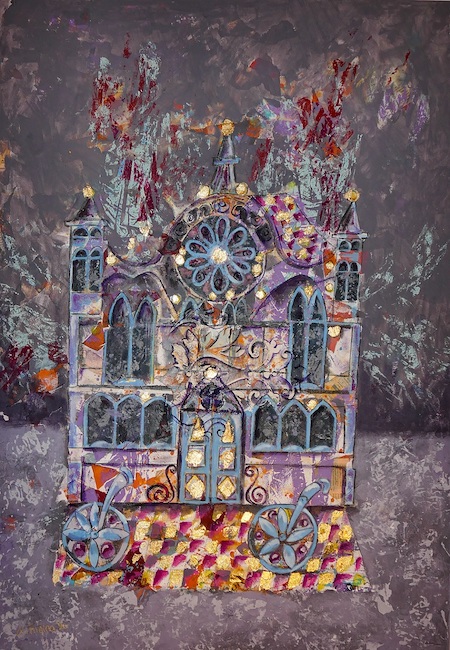
Nell’opera La mia Notre Dame, allo stesso modo, Laura Risina svela la sua inclinazione verso il sogno, verso la trasposizione di tutto ciò che osserva filtrandolo e personalizzandolo con la profondità del suo animo, con la sensibilità che le consente di lasciar emergere le emozioni legate al particolare momento in cui ha avuto davanti agli occhi la straordinaria opera architettonica francese, luogo di culto ma anche di bellezza senza tempo che l’artista trasforma quasi in un castello incantato, di cui immaginare quale vita si svolga al suo interno. Anche in questo caso la spugnatura ha l’effetto della polvere delle fate, quella melodia magica che avvolge i luoghi e le persone che sanno lasciarsi trasportare dalle energie sottili visibili solo a pochi.
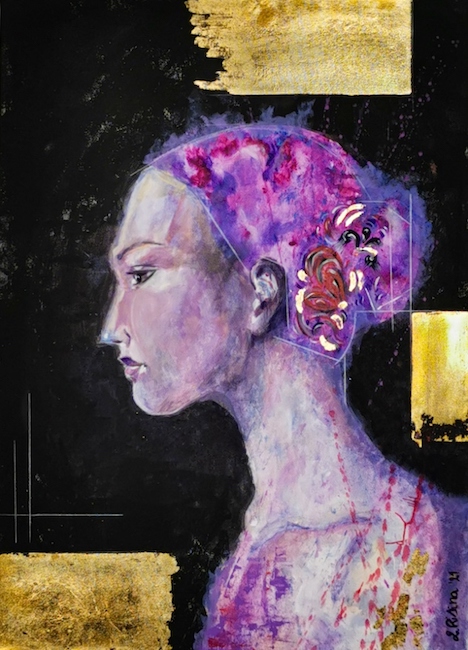
Nella tela Pensami Laura Risina rende protagonista una donna che appare da un lato malinconica perché incerta se l’altro, l’amato, corrisponda le sue stesse emozioni, dall’altro sicura di sé nel sapere che la sua felicità, il suo equilibrio non dipendono da lui bensì le appartengono e la presenza dell’altro può solo arricchire una vita già bella di per sé. La scala di rosa scelta dall’artista per descrivere la protagonista si associa alla dolce memoria di qualcosa che è accaduto recentemente rendendola felice e che ha accompagnato i giorni precedenti fino al momento immortalato in cui desidera che l’altro provi le sue stesse emozioni, che compia quelle azioni che lo porteranno a cercare nuove circostanze e frangenti da condividere.
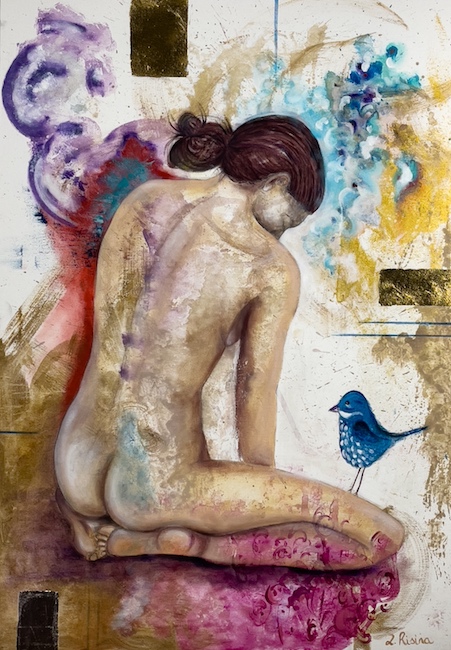
Nella tela Scelte invece la Risina gioca sulle sovrapposizioni, sulle stratificazioni di esperienze e di pensiero che accompagnano l’esistenza rendendola una costante altalena tra tentazione di restare immobili e desiderio di muoversi per progredire ed evolvere, tra paura di sbagliare e certezza che senza scelta non c’è neanche possibilità di trovare la felicità; il corpo nudo è metafora dell’impotenza che a volte l’essere umano prova davanti alla necessità di muoversi consapevolmente verso ciò che costituisce il suo desiderio, e d’altro canto anche la capacità di assumersi la responsabilità di quanto a seguito della decisione intrapresa possa accadere. Le spugnature in questo caso sono più articolate, più graffiate, come se gli strati volessero proteggere ma anche rassicurare la donna raccontata di spalle, come se quelle coperture immaginarie rappresentassero tutti i veli e i timori che spesso impediscono di sollevare la testa e affrontare con coraggio tutto ciò che arriverà.
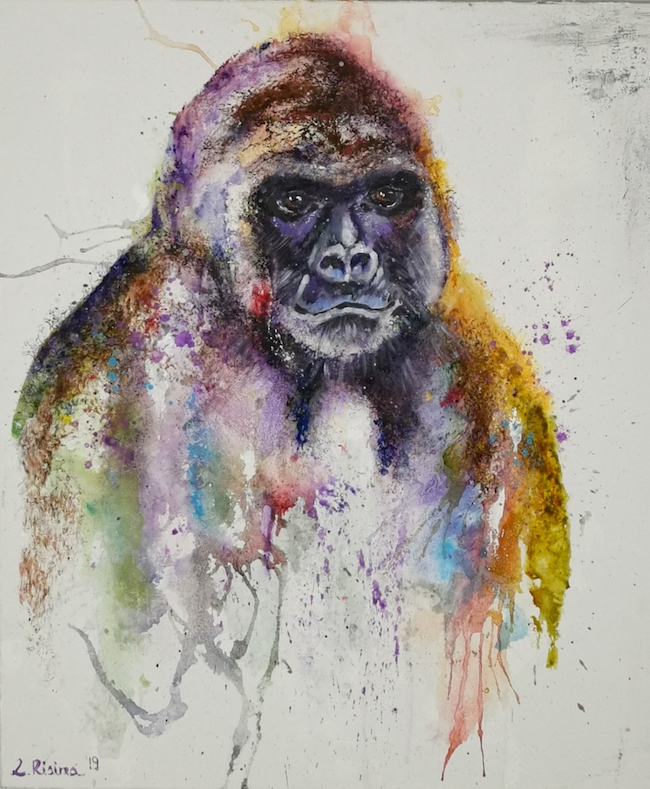
Laura Risina, residente a Milano ormai da molti anni, ha effettuato un percorso di studi tecnici ma ha poi conseguito una specializzazione come grafica pubblicitaria e successivamente come stilista; lavora in un’azienda di telecomunicazioni ma il suo grande amore è la pittura a cui dedica ogni momento libero. Ha all’attivo numerose mostre collettive e personali su tutto il territorio nazionale e fa parte del gruppo artistico Artangolo.
LAURA RISINA-CONTATTI
Email: laura.risina@live.it
Sito web: https://www.laurarisina.it
Facebook: https://www.facebook.com/laura.risina
Instagram: https://www.instagram.com/laurarisina/
Emotions and stardust in Laura Risina’s Magic Realism
In contemporary art we observe two opposing tendencies even if they are generated by the same intentional root, that is to say that of facing contingent reality, one in which the need to sink into themes and sensations, even gloomy or negative ones, is the basis of artistic expression, the other, on the other hand, where the need to escape from pragmatism or inner suffering is manifested in order to take refuge in a world where cultivating pleasantness, pure, almost childlike feelings on which to draw in order to give life to a universe in perfect balance between feeling and the ability to transform everything that surrounds the artist, making it a place to lose oneself in order to connect deeply with emotions. Today’s protagonist belongs to this second category of creatives who prefer to redesign a better world rather than linger within the difficulties and suffering that inevitably belong to current living.
Around the twenties of the twentieth century some artists began to manifest the need for a return to order, a detachment from the excessive dynamism of Futurism and the stylistic deformations of Expressionism; by virtue of this new need to find relevance to observed reality, without forgetting the sensations and the interpretation of everyday life generated by an astonished look at the subtle energies that revolved around objective reality, was borna a style, rather than a real movement, that took the name of Magic Realism. Characterized by a realistic and strongly figurative style, the new pictorial approach had the characteristic of highlighting the alienating aspect of things and consequently of the man who was part of it, sometimes reflective, sometimes dreamy, as if he felt detached from that reality because he was focused on the feeling of having to meditate on something else, something more like the mystery hidden inside things, what children in their innocence and curiosity naturally tend to observe and explore. The artworks of Felice Casorati, Antonio Donghi and Ubaldo Oppi showed a typical human sense of loneliness, of which the artists emphasised the ability to surprise, immersing the characters in the atmosphere rather than in their physical surroundings; as much as Paul Cadmus, in all his artistic production, painted scenes crowded with people, often grotesque moments of leisure, underlining a promiscuity necessary for the human being not to feel lonely but also highlighting how impossible it was for his characters to show happiness, almost as if boredom and habit were prevailing feelings.
As time went on, Magic Realism took on different characteristics, personalised on the basis of the personality of the artist who produced the artwork, sometimes tending towards Surrealism, as in the paintings of the artists Tomek Sętowski and Jaroslaw Jaśnikowski, whose dreamlike landscapes transport the observer into a disturbing and perhaps fascinating world, while others move towards dreams, magic and the ability to change the external appearance of things, enveloping them in positive fantasy. Vladimir Kush belongs to this second expressive intent, whose landscapes made of flowers, butterflies and fruit attract the eye to the point of wanting to be part of that enchanted world. The Sicilian-born artist Laura Risina shows an inclination more similar to Kush’s, although she personalises it on the basis of her own temperamental inclinations, her personal approach that brings her into contact with her own sensitivity, letting her more childlike side come out, her innate ability to maintain surprise and wonder in her gaze. This pure and positive side is manifested in her painting through images that are modified with respect to reality, because they support that different perception with which the artist interprets the observed, the experienced; precisely because of her positive, enchanted approach, Risina finishes her artworks with a sponged effect that gives the sensation of being in front of a glitter, the so-called stardust that has always made children all over the world dream. The narrated atmospheres thus become magical due to the presence of the impalpable effect capable of enriching the observed by communicating the multifaceted range of emotions that from Laura Risina’s interiority reach the emotional chords of the viewer who is won over not only by the image but also by the atmosphere that highlights it and becomes part of the painting itself, essential precisely because for the artist, as for the human being, it is not possible to detach herself from that inner world which is the filter of everything that the eye catches. And it is precisely the emotional involvement of a moment, of a simple instant, that allows her to immortalise a face, an animal, a monument, anything that has captured her attention, recounting it however with that emotionality capable of modifying the real colours to transport them into the world of feeling. From a chromatic point of view, therefore, Risina’s style is close to Expressionism in that it accords not so much with reality as with interiority, but her stroke is linked to the real image, the perspective exists as does the description of her subjects, and so the unusual colouring transports her Realism towards an enchanted, poetic, magical dimension.
The canvas Poetry, in which she chooses an unusual animal, the giraffe, to portray her positive approach to reality, her ability to go beyond contingency and reach out towards the connection with its depths, those that allow her to imagine a different, simpler and therefore more pleasant world, where animals are not so different from human beings and allow the observer to glimpse their personality, their gentleness, an imaginary touch very similar to the dimension in which children constantly live. In the artwork La mia Notre Dame (My Notre Dame), Laura Risina similarly reveals her inclination towards dreams, towards the transposition of everything she observes, filtering and personalising it with the depth of her soul, with the sensitivity that allows her to let emerge the emotions linked to the particular moment in which she had the extraordinary French architectural work in front of her eyes, a place of worship but also of timeless beauty that the artist transforms almost into an enchanted castle, of which she imagines the life that takes place within it. Here too the sponging has the effect of fairy dust, that magical melody that envelops places and people who know how to let themselves be carried away by subtle energies visible only to a few. In the canvas Pensami (Think of Me), Laura Risina portrays a woman who, on the one hand, appears melancholic because she is uncertain whether her beloved corresponds to her own emotions, and on the other hand, self-confident in knowing that her happiness and balance do not depend on him but belong to her and that the presence of another can only enrich a life that is already beautiful in itself.
The scale of roses chosen by the artist to describe the protagonist is associated with the sweet memory of something that has recently happened to make her happy and that has accompanied her through the previous days until the immortalised moment in which she wishes the other person to feel her same emotions, to perform those actions that will lead her to seek new circumstances and junctures to share. In the canvas Scelte (Choices), on the other hand, Risina plays on overlaps, on the stratifications of experience and thought that accompany existence, making it a constant seesaw between the temptation to remain immobile and the desire to move in order to progress and evolve, between the fear of making mistakes and the certainty that without choice there is no possibility of finding happiness; the naked body is a metaphor for the impotence that the human being sometimes feels when faced with the need to move consciously towards what constitutes his desire, and on the other hand also the ability to take responsibility for what may happen as a result of the decision taken. The sponges in this case are more articulated, more scratched, as if the layers wanted to protect but also reassure the woman told from behind, as if those imaginary covers represented all the veils and fears that often prevent one from lifting one’s head and facing with courage all that will come. Laura Risina, who has lived in Milan for many years now, studied technical subjects but then specialised as an advertising graphic designer and later as a stylist; she works in a telecommunications company but her great love is painting, to which she dedicates every spare moment. She has had numerous group and personal exhibitions throughout Italy and is a member of the Artangolo art group.


